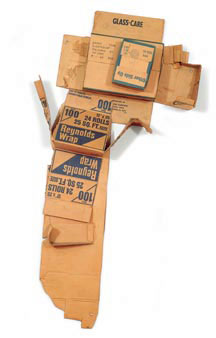Sponsorship by TFAA and the Cultural Services of the French Embassy
On view from June 8 through September 16, 2007, the exhibition features works by Max Ernst, René Magritte, Jackson Pollack, Mark Rothko, Jean Tinguely, and African, Oceanic, and Pre-Columbian art. The exhibition opens on the Menil Collection’s 20th Anniversary date.
 HOUSTON, May 18, 2007 — A MODERN PATRONAGE: de Menil Gifts to American and European Museums continues the Menil’s celebration of its 20th anniversary.
HOUSTON, May 18, 2007 — A MODERN PATRONAGE: de Menil Gifts to American and European Museums continues the Menil’s celebration of its 20th anniversary.
Organized by Menil director Josef Helfenstein, this exhibition brings together for the first time approximately 45 major works of art that John and Dominique de Menil donated to museums in Europe and America, including the Centre Georges Pompidou, Paris; Musée du quai Branly, Paris (formerly the L’Musée del Homme); the Museum of Modern Art, New York (MoMA); the Museum of Fine Arts, Houston (MFAH); as well as The Menil Collection (which opened to the public on June 8, 1987).
“We feel very close to the Museum of Modern Art, and we like to give you the kind of things in which we believe,” John de Menil wrote in December 1955 to Alfred H. Barr, Jr., founding director of MoMA. The letter accompanied one of the de Menils’ first gifts to a museum in December 1955 — and set the stage for many subsequent decades of generosity. De Menil’s words revealed his deep belief in the power of the primacy of art, a philosophy of intuitive collecting and giving that he shared with Dominique (1908-1997). A MODERN PATRONAGE is more than a reunion of works of art or homage to their donors. In planning the exhibition, said Josef Helfenstein, “a fascinating story emerged. Bringing together pieces of the puzzle provided an opportunity to understand the philosophy that guided the de Menils’ approach to patronage. I hope this exhibition helps to illustrate that the Menil embodies the founders’ open-door approach to thinking about the possibilities of art.” 
Beginning with works purchased as early as the 1940s, the exhibition presents attests to the de Menils’ interest in establishing a conversations between significant 20th-century artists ; — including Max Ernst, René Magritte, Man Ray, Mark Rothko, Jean Tinguely, Wols, Lee Bontecou, Jackson Pollock, Claes Oldenburg, Larry Rivers, and Andy Warhol , — and important selections of African, Oceanic, and Pre-Columbian art.
Accompanying the exhibition is a fully illustrated catalogue, with essays by Marcia Brennan, Alfred Pacquement, and Ann Temkin, exploring the complex set of circumstances that inspired the development and international reach of the de Menils’ artistic vision. Pacquement, the director of the Centre Pompidou, Paris, discusses Dominique de Menil’s pioneering role in bringing modern American Art to France in the 1970s.
In honor of her late husband, Dominique gave to the Pompidou at its 1977 inauguration a monumental Abstract Expressionist work by Jackson Pollock, The Deep (1953). Atypical of Pollock’s well-known drip paintings, with the work features a central composition that verges on the figural, its the unique and dramatic nature of the work led leading MoMA curator Frank O’Hara to describe the painting as “a work which contemporary aesthetic had cried out for … one of the provocative images of our time, an abyss of glamour encroached upon by a flood of innocence.”
The couple’s belief in individuals and objects vision led them to make deep their commitments to particular artists, including, famously, Surrealists such as Magritte and Ernst, and Jean Tinguely. Visiting the Swiss sculptor’s 1964 show at Alexandre Iolas’s Paris gallery, John was so inspired by what he saw, and heard — a cacophonous gathering of spurting and rocking machines consisting of rubber belts and electric motors — that he purchased every work on display for the MFAH. A selection of these Meta-Mecanique sculptures will be assembled for A MODERN PATRONAGE.
Demonstrating a truly modern patronage, the de Menils’ role as collectors transcends the works of art held by The Menil Collection, and this exhibition honors their international scope and presence.




 By the time Robert Rauschenberg completed the first of his Cardboards in 1971, he had already been breaking ground as an artist for twenty years. He first gained international acclaim in 1958 when he exhibited twenty of his Combines at the Leo Castelli Gallery in New York City. By amalgamating an unprecedented variety of discarded objects, materials, and artistic techniques, the Combines not only provided the first significant break with the tenets of Abstract Expressionism, but also introduced a new type of art object, neither sculpture nor painting, neither abstract nor representational.
By the time Robert Rauschenberg completed the first of his Cardboards in 1971, he had already been breaking ground as an artist for twenty years. He first gained international acclaim in 1958 when he exhibited twenty of his Combines at the Leo Castelli Gallery in New York City. By amalgamating an unprecedented variety of discarded objects, materials, and artistic techniques, the Combines not only provided the first significant break with the tenets of Abstract Expressionism, but also introduced a new type of art object, neither sculpture nor painting, neither abstract nor representational.


